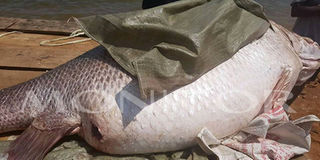How the Nile Perch has damaged Lake Victoria

Nile perch weighing 174kgs at Mulungu landing site, Munyonyo, Uganda. Nile Perch is said to have damaged Lake Victoria by eating other fish species. Photo | File
What you need to know:
- Even more laughable, some East African presidents have formed special military units to patrol the lake and seize the illegal nets. These days, political desperation to salvage the situation is real. But to save the lake requires more than military intervention or the continued harassment of fishermen in Migingo by Yoweri Museveni’s police.
This is the painful story of Lake Victoria — and there is a question that needs an urgent answer.
How do we undo a colonial mistake that damaged the Lake Victoria food chain? Forget all the tales you have heard about illegal fishing nets as the number one contributor to dwindling catches.
Even more laughable, some East African presidents have formed special military units to patrol the lake and seize the illegal nets. These days, political desperation to salvage the situation is real. But to save the lake requires more than military intervention or the continued harassment of fishermen in Migingo by Yoweri Museveni’s police.
I have noted that discussions on Lake Victoria’s dwindling catches skirt around the tragic story of what happened. In 1954, somebody introduced the Nile perch into Lake Victoria, which had its indigenous fish variety.
Nile perch (known as mputa in Uganda) was not native to this lake, whose indigenous species had stabilised in the last 17,000 years after the lake dried up for some years and then filled up again. But the desire to have fish for the European markets and sports has now led to an ecological disaster, a concern that has not been amplified enough.
The change in the Lake Victoria food chain has been an ongoing debate in environmental journals. Scientists, those not burying their heads in the sand, say that Lake Victoria is facing an ecological disaster — thanks to the Nile perch.
At first, the Nile perch was introduced to some ponds around the lake as part of the colonial government’s bid to develop fisheries among communities further from the lake. That was before colonial officials in Uganda secretly introduced the predator to the lake in 1954. There seems to be no recorded alarm even after Food and Agriculture Organisation scientists reported that several fingerlings had found their way into the lake. We know that biologists — especially in Kenya — were openly opposed to the deliberate introduction of a predator into the lake.
Non-native tilapia
In 1959, once again, the fisheries department in Uganda introduced more Nile perch into the lake after overriding scientific advice and the concerns of their colleagues in Kenya and Tanzania.
There are also records indicating that in May 1962, some 35 fish ranging from 16.0 to 43.5 cm in length were introduced into the lake, followed by 339 fingerlings in September 1963.
These were brought from Uganda’s Lake Albert. Finally, eight fish varieties from Lake Turkana were introduced in 1963, bringing the total to 382.
Another experiment carried out in the 1950s was the introduction of several non-native tilapia, but it seems that only the Nile tilapia survived.
Previously, the Nile perch had not reached the lake because the Kabalega and Owen Falls deterred it, and so Lake Victoria was naturally protected from this predator. Today, Owen Falls, and the nearby Rippon Falls, are no more after they were submerged in 1953 during the construction of a power station in at Jinja. But a human error has allowed the Nile perch to colonise the lake.
It was in the 1980s that the Nile perch population exploded — to the surprise of scientists. Besides that, scientists say there were changes in the lake that had evolved from its previous “oligotrophic state” — meaning a lake with clear waters and little sediment — to the current “eutrophic state”, which can be described as a polluted lake with dense plant population. This later state kills more fish.
They have now been asking why it took Nile perch 20 years to reach this level of domination. By 1984, the biomass of Nile perch had exceeded all other species, whose numbers had significantly dwindled. Some species had also disappeared or become extinct.
While the introduction of Nile perch saw the commercialisation of the lake — and a viable fishing industry was built around the predator, one question that was never answered was what this predator would feed on after becoming the dominant species. More so, it was unpopular.
Indigenous tilapia
In 1982, then-Natural Resources minister of Kenya, Odongo Omamo took that question to Parliament: “This kind of fish is carnivorous; it feeds on other smaller fish to the extent that the other smaller species, such as tilapia, also known as ngege, can hardly be found.”
Omamo complained that Nile perch grows very fat, “and when it is caught, no one wants to eat it because there is so much fat. I would like to appeal to the Ministry of Health to come up with a better way of cooking Nile perch so that it can be edible.”
Omamo’s concern was that the indigenous fish culture was being replaced. More so, an entire economy could face ruin.
While the Nile perch, which could grow to 130 kilogrammes, was meant for export, the indigenous tilapia fish for the local market was becoming expensive since it was rare.
In 1982, then-Natural Resources minister Odongo Omamo took that question to Parliament: “This kind of fish is carnivorous; it feeds on other smaller fish to the extent that the other smaller species, such as tilapia, also known as ngege, can hardly be found.” Omamo complained that Nile perch grows very fat, “and when it is caught, no one wants to eat it because there is so much fat. I would like to appeal to the Ministry of Health to come up with a better way of cooking Nile perch so that it can be edible.”
Omamo’s concern was that the indigenous fish culture was being replaced. More so, an entire economy could face ruin.
While the Nile perch, which could grow to 130 kilogrammes, was meant for export, the indigenous tilapia fish for the local market was becoming expensive since it was rare.
In 1985, a study by Leiden University raised concerns and provided data indicating that Lake Victoria would face a catastrophe. That was when Australia wanted to introduce Nile perch to one of its lakes. The plan was dropped following the Lake Victoria study.
Today, it is not known how many species have disappeared from the lake, though some scientists wonder why the Nile perch managed to co-exist with tilapia in Lake Turkana, Lake Albert and Lake Chad, and with minor damage to the food chain.
In 1988, the New Scientist tried to defend the monster fish and quoted some biologists blaming “overfishing with fine-meshed nets” as the other culprit. Unfortunately, since little can be done on the Nile perch, we have resorted to the narrative of nets and over-fishing.
In 2008, scientists reported that the Nile perch, having exhausted all the other species, was increasingly feeding on their young or small shrimp. In 1988, the World Conservation Union (IUCN) listed 596 fresh-water fishes in danger of extinction; almost half were in Lake Victoria.
Fished away to extinction
In the short term, the Nile perch gave us the illusion that a viable fishing industry was possible with its introduction. However, with its colonisation of the lake, tilapia became rare and expensive.
The only way out, some scientists say, would be for the Nile perch to run out of food and decline. That would give room to other species to thrive. Other scientists suggest that the predator can be fished away to extinction. How? I don’t know.
When you look at the tussle over Migingo, it is about the desperation of local fishermen trying to fish from the last tilapia colonies. What is required is an open discussion and research on measures to take — in the short term and in the long term to undo the 70-year-old colonial error.
If you have been wondering why tilapia is so expensive, it is because of this monster — plus the other pollution factors.





